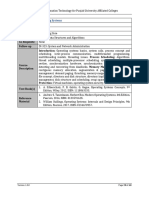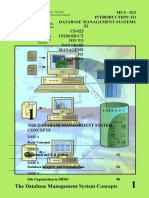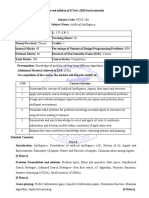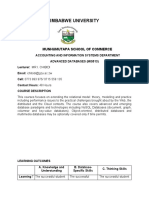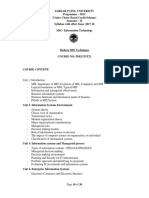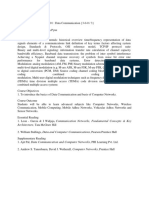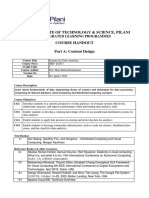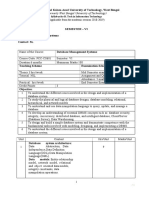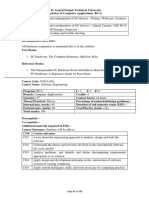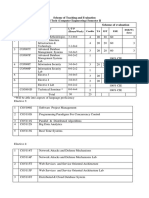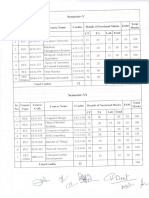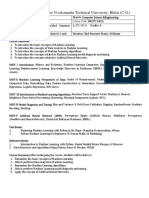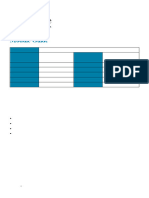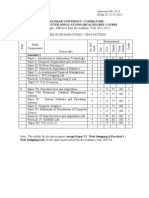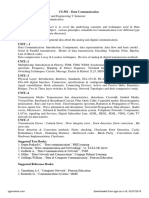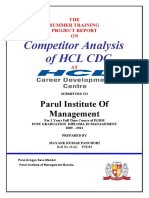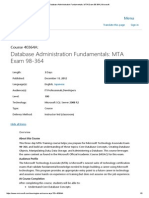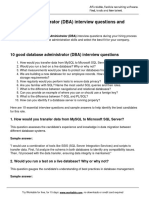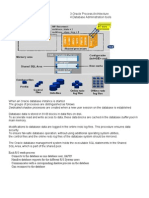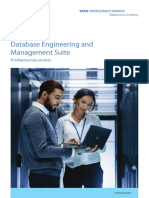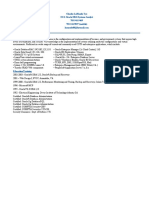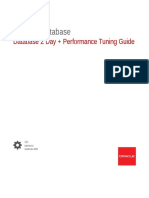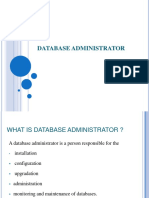0 ratings0% found this document useful (0 votes)
9 views7th Semester Outline
7th Semester Outline
Uploaded by
ayeshajawed7862PU Course outlines for BS IT program
Copyright:
© All Rights Reserved
Available Formats
Download as PDF, TXT or read online from Scribd
7th Semester Outline
7th Semester Outline
Uploaded by
ayeshajawed78620 ratings0% found this document useful (0 votes)
9 views12 pagesPU Course outlines for BS IT program
Copyright
© © All Rights Reserved
Available Formats
PDF, TXT or read online from Scribd
Share this document
Did you find this document useful?
Is this content inappropriate?
PU Course outlines for BS IT program
Copyright:
© All Rights Reserved
Available Formats
Download as PDF, TXT or read online from Scribd
Download as pdf or txt
0 ratings0% found this document useful (0 votes)
9 views12 pages7th Semester Outline
7th Semester Outline
Uploaded by
ayeshajawed7862PU Course outlines for BS IT program
Copyright:
© All Rights Reserved
Available Formats
Download as PDF, TXT or read online from Scribd
Download as pdf or txt
You are on page 1of 12
Curricula/Syllabi of BS Information Technology for Punjab University Affiliated Colleges
Course Title Data Science
Course Code EI-334
Credit Hours 3
Category Technical Elective
Prerequisite DI-326: Artificial Intelligence
Co-Requisite None
Follow Up None
Python Programming: Environment, python programming techniques such as
lambdas, reading and manipulating csv files, and the numpy library. Data
Manipulation and Cleaning: Python Pandas data science library, abstraction of
Course the Series and DataFrame as the central data structures for data analysis,
Description functions such as groupby, merge, and pivot tables. Inferential Statistical
Analyses. Machine learning vs Descriptive Statistics, scikit learn toolkit, data
dimensionality, clustering, evaluating clusters. Supervised Learning: predictive
modelling, data generalizability, cross validation, Overfitting.
1. Joel Grus, Data Science from Scratch: First Principles with Python, 1st Edition,
Text Book(s)
O'Reilly, 2015, ISBN: 1-491-90142-X.
1. https://www.coursera.org/specializations/data-science-python
2. https://www.coursera.org/learn/python-data-analysis/home/info
Reference
3. https://www.coursera.org/degrees/master-of-computer-science-asu
Material
4. https://www.coursera.org/degrees/master-of-applied-data-science-umich
5. https://www.coursera.org/degrees/masters-in-computer-data-science
Version 1.0.0 Page 46 of 68
Curricula/Syllabi of BS Information Technology for Punjab University Affiliated Colleges
3. INFORMATION TECHNOLOGY DOMAIN CORE COURSES
Course Title IT Project Management
Course Code DI-321
Credit Hours 3
Category Domain Core
Prerequisite None
Co-Requisite None
Follow Up None
Introduction: Project Management. Project Management in Information
Technology Context. The Project Management Process Groups. Scope triangle,
The S curve. Five Phases of Project Management Life Cycle: Defining,
planning, executing, controlling, closing, Scope of project, Project Work
Breakdown Structure (WBS), Project Time Management. Estimate Activity
Duration: Causes of variation in activity duration, five methods of Estimating
Activity Duration. Project Networks: Critical Path Method (CPM), Build the
project network, Analysis of the project network, Project Evaluation Review
Technique (PERT), Activity on Arrow, Activity on Node, GANTT Chart, Using MS-
Project to draw GANTT chart and project Networks. Project Proposal: Purpose
of the project proposal, Contents of the project proposal, Format of the Project
Course
Proposal. Staffing and Personnel Planning: Personnel Plan, Team structures,
Description
Democratic decentralized, Controlled Decentralized, Controlled Centralized,
Coordination and communication issues, Maslow’s need theory of motivation,
Software Project Team Roles and Responsibilities, Risk Identification, Analysis
and Management. Project Management: Integration Management. Scope
Management. Cost Management. Quality Management. Human Resource
Management. Communications Management. Risk Management. Procurement
Management. Management Tools. Configuration Management: Change
Management and Control, baselines, Version Control, Earned Value Analysis for
Project Monitoring and Control. Examples of Earned Value Analysis, Project
Quality Assurance Plans, SQA Process Project Quality Standards, Project
Documents.
1. Guide to the Project Management Body of Knowledge (PMBOK® Guide), 6th
Text Book(s)
Edition, Project Management Institute, 2017, ISBN-10: 1628251840.
Reference 1. Teresa Luckey, Joseph Phillips, Software Project Management for Dummies,
Material 1st Edition, For Dummies Publisher, 2006, ISBN 0471749346.
Version 1.0.0 Page 32 of 68
Curricula/Syllabi of BS Information Technology for Punjab University Affiliated Colleges
Course Title Cyber Security
Course Code DI-325
Credit Hours 3
Category Domain Core
Prerequisite
Co-Requisite None
Follow-up None
Topics: Basic security concepts, Information security terminology, Malware
classifications, Types of malware. Server-side web applications attacks. Cross-
Course
site scripting, SQL Injection, Cross-site request forgery, Planning and policy,
Description
Network protocols and service models. Transport layer security, Network layer
security, Wireless security, Cloud & IoT security.
1. Mark Ciampa, Security+ Guide to Network Security Fundamentals, 4th
Text Book(s)
Edition.
Reference
1. Randall J. Boyle, Corporate Computer Society, 3rd Edition.
Material
Version 1.0.0 Page 39 of 68
Curricula/Syllabi of BS Information Technology for Punjab University Affiliated Colleges
Course Title Database Administration and Management Lab
Course Code DI-324L
Credit Hours 1
Category Domain Core
Prerequisite CC-312: Database Systems
Co-Requisite None
Follow-up None
Introduction: to Enterprise Database Systems. Oracle Architectural
Components: What is Introduction to Enterprise Database Systems,
Responsibilities of Database Administrator. Oracle Server; Oracle Instance;
Physical Structure. Creating Database and Data dictionary: Creation
Prerequisites; Creating Database; Starting Instance. Data Dictionary; Data
Dictionary Contents. Dynamic Performance Views. Managing Control Files and
Redo Log Files: Control File; Control File Contents; Multiplexing Control File;
Using Redo Log Files; Structure of Redo Log File; Adding Redo Log Groups and
Members; s. Managing Tablespaces: Database Storage Hierarchy; Kinds of
Tablespaces; Managing Data files. Storage Structure and Relationships:
Adding Data files and other Operations with Data files; Types of Segments.
Managing Undo Data: Undo Segment; Read Consistency; Automatic undo
Management: Managing Tables. Managing Users: Creating Users; Managing
Course Users; Creating Tables; Managing Tables. Managing Indexes: types of Indexes;
Description Creation and Management of Indexes. Maintaining Data Integrity: Types of
Constraints; Managing Constraints. Managing Privileges: System Privileges;
Object Privileges. Managing Roles: Assign and Revoke Roles and Roles
Management. Network overview, Configuring Listener; Sessions. Client-Side
Configuration: Host Naming Method; Local Naming Method; Net Assistant;
Configurations of Different Methods. Usage and Configuration of Oracle
Shared Server: Server Configuration; Dedicated Server Process; Shared Server
Process. Backup and Recovery: overview, Instance and Media Recovery,
Categories of Failure; Defining Backup and Recovery Strategy. Configuration of
Archive log mode: Switching to Archive Log Mode; Archive Process. User
Managed Backups: User Managed backups and Issues. User Managed
Complete Recovery: How To recover a Database Manually Using Manual
Backups. User Managed Incomplete Recovery: How to DO an Incomplete
Recovery. Import/Export: Different export and import modes.
1. Oracle 11i DBA Fundamentals I (Student Guide, Volume I and II).
Text Book(s) 2. Oracle 11i DBA Fundamentals II (Student Guide, Volume I and II).
3. Performance Tuning (Student Guide, Volume I and II).
Reference 1. Oracle Magazine.
Material 2. Online Material URL http://otn.oracle.com/
Version 1.0.0 Page 38 of 68
Curricula/Syllabi of BS Information Technology for Punjab University Affiliated Colleges
Course Title Database Administration and Management
Course Code DI-324
Credit Hours 3+1
Category Domain Core
Prerequisite CC-312: Database Systems
Co-Requisite None
Follow-up None
Introduction to advanced data models such as object relational, object oriented.
File organization concepts, Transactional processing and Concurrency control
Course techniques, Recovery techniques, Query processing and optimization, Database
Description Programming, Integrity and security, Database Administration, Physical
database design and tuning, Distributed database systems, Emerging research
trends in database systems.
1. Ramez Elmasri, Shamkant Navathe, Fundamentals of Database Systems, 6th
Text Book(s)
Edition, Addison Wesley, 2010, ISBN: 0136086209.
Reference 1. Henry F. Korth, Abraham Silberschatz, Database System Concepts, 6th
Material Edition, McGraw Hill, 2010, ISBN: 0073523321.
Version 1.0.0 Page 37 of 68
You might also like
- 1.1 Fundamentals of Database Systems - Solutions PDFDocument721 pages1.1 Fundamentals of Database Systems - Solutions PDFTeam Drive50% (4)
- Manual Work Immersion PDFDocument26 pagesManual Work Immersion PDFAllen Iverzon EusebioNo ratings yet
- Semester VIIDocument8 pagesSemester VIIsohaibchNo ratings yet
- 4 Bca 4th Sem Syllabus UemjDocument12 pages4 Bca 4th Sem Syllabus Uemjapi-351162654No ratings yet
- MSC IT 2nd SemesterDocument10 pagesMSC IT 2nd SemesterWaseem Abbas100% (1)
- CC311_mergedDocument5 pagesCC311_mergedhockwell786No ratings yet
- 2nd Sem, Data Science SyllabusDocument16 pages2nd Sem, Data Science Syllabusas5280199No ratings yet
- B Tech II Year Iv CSE Syllabus 2019 20Document9 pagesB Tech II Year Iv CSE Syllabus 2019 20qurekaabhiNo ratings yet
- V Sem Syllabus 2020-21200121020338270921011611Document13 pagesV Sem Syllabus 2020-21200121020338270921011611Anmol SharmaNo ratings yet
- 3 Semester Mtce 701 A Knowledge Based System Design: ReferencesDocument8 pages3 Semester Mtce 701 A Knowledge Based System Design: ReferencesZeeshan KhursheedNo ratings yet
- MSCIT SyllabusDocument30 pagesMSCIT SyllabusVIHAN SHARMANo ratings yet
- Course Coordinatoi: DR.: SubjectDocument8 pagesCourse Coordinatoi: DR.: Subjectmgrstudio100No ratings yet
- Advanced Database Management SystemsDocument7 pagesAdvanced Database Management Systemsvelmurugan13777No ratings yet
- MCS 023 Block 1Document114 pagesMCS 023 Block 1Sadhika VandanamNo ratings yet
- Unit 4: Database Design & Development: Unit Code H/615/1622 Unit Type Core Unit Level 4 Credit Value 15Document7 pagesUnit 4: Database Design & Development: Unit Code H/615/1622 Unit Type Core Unit Level 4 Credit Value 15Ashara tmelNo ratings yet
- Scheme and Syllabus of B.Tech. (2018 Batch Onwards)Document14 pagesScheme and Syllabus of B.Tech. (2018 Batch Onwards)Suri SrNo ratings yet
- MIS513 Advanced Datavbases Course OutlineDocument8 pagesMIS513 Advanced Datavbases Course OutlineAlfa KarubaNo ratings yet
- IT Sem 4Document17 pagesIT Sem 4Nikhil KhandelwalNo ratings yet
- CC6 Week 4 Chapter 2Document21 pagesCC6 Week 4 Chapter 2jerwin dacumosNo ratings yet
- RDBMSDocument5 pagesRDBMSChannveer MulgeNo ratings yet
- BCA SYLLABUS 2023Document9 pagesBCA SYLLABUS 2023vijay.official2050No ratings yet
- IT 7thDocument10 pagesIT 7thSumit KrNo ratings yet
- BTech CSE Third Year SyllabusDocument5 pagesBTech CSE Third Year SyllabusAnkush KumarNo ratings yet
- MSC ItDocument10 pagesMSC ItPatel BansariNo ratings yet
- DS Curriculum 2024Document12 pagesDS Curriculum 2024che215capcNo ratings yet
- SylabiiDocument6 pagesSylabiiashit kumarNo ratings yet
- 0b9e4data Warehousing and Data Mining - MergedDocument14 pages0b9e4data Warehousing and Data Mining - MergedAkhil_Jain_1678No ratings yet
- Bca Iii DBMS SyllabusDocument4 pagesBca Iii DBMS SyllabusrightisbeautyNo ratings yet
- Course Syllabus of IT PG PDFDocument39 pagesCourse Syllabus of IT PG PDFteklayNo ratings yet
- Database Management System For Online PDFDocument151 pagesDatabase Management System For Online PDFSaurabh RautNo ratings yet
- Ju It Syllabus Pmit 2015Document42 pagesJu It Syllabus Pmit 2015asreetoNo ratings yet
- Birla Institute of Technology & Science, Pilani: Work Integrated Learning ProgrammesDocument9 pagesBirla Institute of Technology & Science, Pilani: Work Integrated Learning ProgrammeskhkarthikNo ratings yet
- BSC CSIT 7th Semester SyllabusDocument19 pagesBSC CSIT 7th Semester SyllabusFiroj GhimireNo ratings yet
- 7 SemDocument8 pages7 Semraju rama raj kumarNo ratings yet
- 1133-B.sc IT (Bachelor of Science in Information Technology) (Lateral Entry in 2nd Year)Document25 pages1133-B.sc IT (Bachelor of Science in Information Technology) (Lateral Entry in 2nd Year)Dilpreet SinghNo ratings yet
- DBIRS SyllabusDocument2 pagesDBIRS SyllabusAshitosh KadamNo ratings yet
- Sem 6Document23 pagesSem 6Soumya BeraNo ratings yet
- Java Programming Course Outline: ObjectivesDocument3 pagesJava Programming Course Outline: ObjectivesjpsahooNo ratings yet
- 3rd semCompEng SemesterIIIDocument12 pages3rd semCompEng SemesterIIIdevyansh.d09No ratings yet
- Syllabus B.sc. Computer ScienceDocument17 pagesSyllabus B.sc. Computer Sciencestandalong907No ratings yet
- BCA 1st To 6th 1Document14 pagesBCA 1st To 6th 1Ravi KumarNo ratings yet
- 1 DBIntro F24Document46 pages1 DBIntro F24saboorfarooq247No ratings yet
- SystemaForDataAnalytics Regular HODocument10 pagesSystemaForDataAnalytics Regular HORoma ThakareNo ratings yet
- (Formerly West Bengal University of Technology) : (Applicable From The Academic Session 2018-2019)Document26 pages(Formerly West Bengal University of Technology) : (Applicable From The Academic Session 2018-2019)arindamsinharayNo ratings yet
- Applied Computation 263 Data and Computation On The InternetDocument5 pagesApplied Computation 263 Data and Computation On The InternetMartita UriarteNo ratings yet
- Database Management System: Biyani's Think TankDocument204 pagesDatabase Management System: Biyani's Think Tankjanet gracesusilaNo ratings yet
- Fy Mtech Sem2 Ay2014 15Document31 pagesFy Mtech Sem2 Ay2014 15swapnil0% (1)
- 3rd CSE IT New Syllabus 2019 20Document19 pages3rd CSE IT New Syllabus 2019 20Harsh Vardhan HBTUNo ratings yet
- BTech - CSE - 7thsem - Syllabus For WebsiteDocument21 pagesBTech - CSE - 7thsem - Syllabus For WebsiteArindam VermaNo ratings yet
- Dbms Notes Be Sem 5wbebDocument243 pagesDbms Notes Be Sem 5wbebsangamsri88No ratings yet
- 1682499359916-BTechCSE 6thsemester Upload 26 4 2023Document12 pages1682499359916-BTechCSE 6thsemester Upload 26 4 2023wanimohsin015No ratings yet
- ITDA310 - Module Guide S1 2019 (V1.0)Document10 pagesITDA310 - Module Guide S1 2019 (V1.0)Ewald SteenkampNo ratings yet
- D B M SDocument4 pagesD B M SKutbuddin AmbawalaNo ratings yet
- RGPV Syllabus Cbgs Cs 6 Sem All Subjects PDFDocument12 pagesRGPV Syllabus Cbgs Cs 6 Sem All Subjects PDFelectronNo ratings yet
- Scheme of Work March 2018Document6 pagesScheme of Work March 2018NUR FAIZAH BINTI ROSLAN STUDENTNo ratings yet
- HTTP App - Utu.ac - in Utuexmanagement Exammsters Syllabus CE4012 Database Management System - Docx - 2Document6 pagesHTTP App - Utu.ac - in Utuexmanagement Exammsters Syllabus CE4012 Database Management System - Docx - 221amtics440No ratings yet
- MCA2013 IISem SyllabusDocument9 pagesMCA2013 IISem SyllabusvijayakumarknNo ratings yet
- CC6 Week 3 Chapter 2Document42 pagesCC6 Week 3 Chapter 2jerwin dacumosNo ratings yet
- Syllabus For The Post of Assistant Manager (MIS)Document1 pageSyllabus For The Post of Assistant Manager (MIS)Gonika SharmaNo ratings yet
- Syllabus CS-0000 V Sem All SubjectDocument11 pagesSyllabus CS-0000 V Sem All Subject12ashivangtiwariNo ratings yet
- Hands-On Data Preprocessing in Python: Learn how to effectively prepare data for successful data analyticsFrom EverandHands-On Data Preprocessing in Python: Learn how to effectively prepare data for successful data analyticsNo ratings yet
- Microsoft SQL Server Database CertificationsDocument3 pagesMicrosoft SQL Server Database CertificationsDocktee Gh100% (1)
- Assignment 1 CCE-223Document7 pagesAssignment 1 CCE-223Sadia Islam ShefaNo ratings yet
- Chapter 1Document21 pagesChapter 1Anosha KhanNo ratings yet
- Versant Database v.7.0.1.0 Administration ManualDocument465 pagesVersant Database v.7.0.1.0 Administration ManualdpnswNo ratings yet
- Project of HCL CDC 2 Final ReportDocument76 pagesProject of HCL CDC 2 Final Reportroomno0% (1)
- NAVVTC New Free Database Administration (DBA) Course 2024-2025Document5 pagesNAVVTC New Free Database Administration (DBA) Course 2024-2025hibaarif067No ratings yet
- MSSQL-AzureSQL DBA PDFDocument12 pagesMSSQL-AzureSQL DBA PDFArun Maan50% (2)
- Database Administration Fundamentals - MTA Exam 98-364 - MicrosoftDocument5 pagesDatabase Administration Fundamentals - MTA Exam 98-364 - Microsofttwizas392650% (2)
- DBA Module 2Document16 pagesDBA Module 2melkamu endaleNo ratings yet
- MicroStrategy Education Catalog PDFDocument80 pagesMicroStrategy Education Catalog PDFpraveenindayNo ratings yet
- Database Administrator Dba Interview QuestionsDocument5 pagesDatabase Administrator Dba Interview QuestionsAdil AnwerNo ratings yet
- SAPDBA UtilitiesDocument4 pagesSAPDBA Utilitiesapi-3757886No ratings yet
- Database Engineering Management Suite Brochure PDFDocument4 pagesDatabase Engineering Management Suite Brochure PDFManpreet SinghNo ratings yet
- (Ebooks PDF) Download (Ebook PDF) Database Processing Fundamentals, Design, and Implementation, 15th Edition Full ChaptersDocument41 pages(Ebooks PDF) Download (Ebook PDF) Database Processing Fundamentals, Design, and Implementation, 15th Edition Full Chaptersypilsdsu100% (9)
- Daryl Classen: SkillsDocument3 pagesDaryl Classen: SkillsdarylNo ratings yet
- BIT352 - Database AdministrationDocument2 pagesBIT352 - Database Administrationrijanrai881No ratings yet
- 1Z0-052 Dumps - Oracle Database Administration ExamDocument9 pages1Z0-052 Dumps - Oracle Database Administration ExamThomas William100% (1)
- DB6 LUW DBA CockpitDocument244 pagesDB6 LUW DBA CockpitJonathan CarrilloNo ratings yet
- Bernard EderDocument11 pagesBernard Ederkiran2710No ratings yet
- U.S. Citizen: Charles Lamonde Tye Oca Oracle Dba/Systems Analyst 703-941-9469 703-244-9027 (Mobile)Document6 pagesU.S. Citizen: Charles Lamonde Tye Oca Oracle Dba/Systems Analyst 703-941-9469 703-244-9027 (Mobile)vikas kumarNo ratings yet
- Oracle Database Administrator (DBA) Salary Guide - Oracle UniversityDocument1 pageOracle Database Administrator (DBA) Salary Guide - Oracle UniversityMuhammadimran AliNo ratings yet
- 20462C ENU TrainerHandbookDocument430 pages20462C ENU TrainerHandbookJonas Ruiz100% (5)
- Administering Microsoft SQL Server DatabasesDocument4 pagesAdministering Microsoft SQL Server DatabasesMuthu Raman ChinnaduraiNo ratings yet
- Vapo Seze Dulal Odus A KawDocument3 pagesVapo Seze Dulal Odus A KawIrfan AslamNo ratings yet
- 2 Day Performance Tuning GuideDocument195 pages2 Day Performance Tuning Guidenemat123No ratings yet
- Caritor - Oracle SI - V.5Document36 pagesCaritor - Oracle SI - V.5Sreenivasulu kNo ratings yet
- Week 1 Database AdministratorDocument34 pagesWeek 1 Database AdministratorWaleed AhmadNo ratings yet
- OracleDBA Resume 13+yearsDocument3 pagesOracleDBA Resume 13+yearsSaharsh GoyalNo ratings yet





